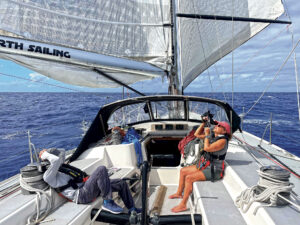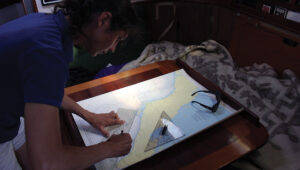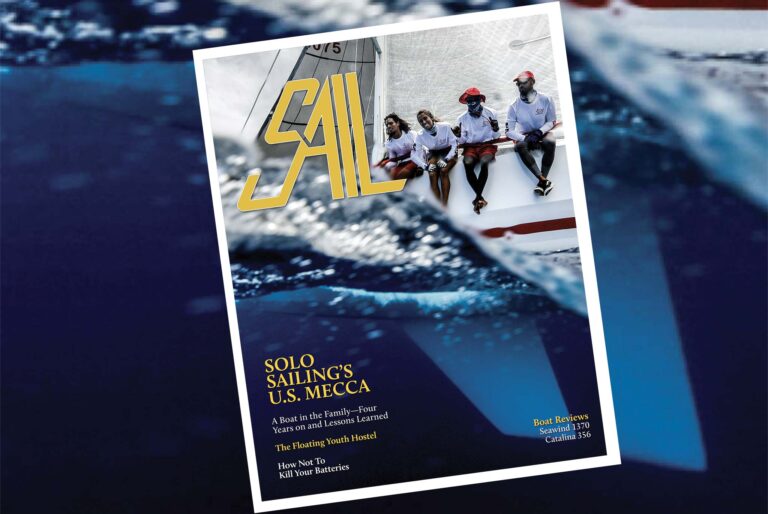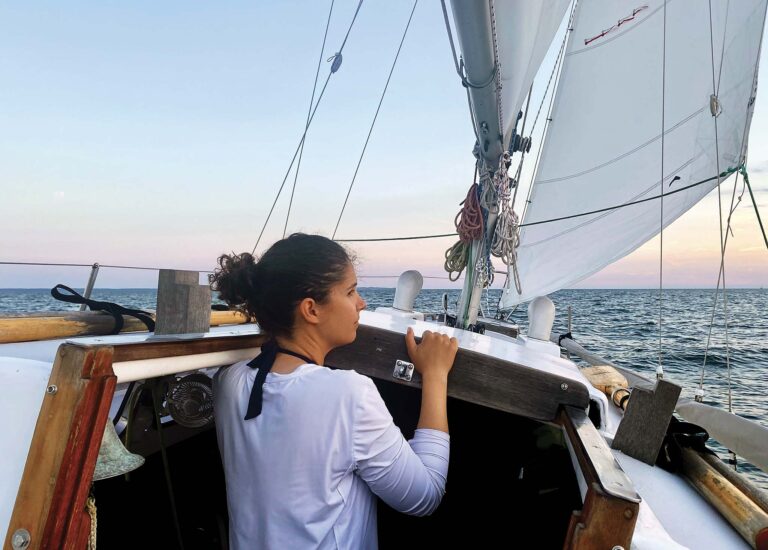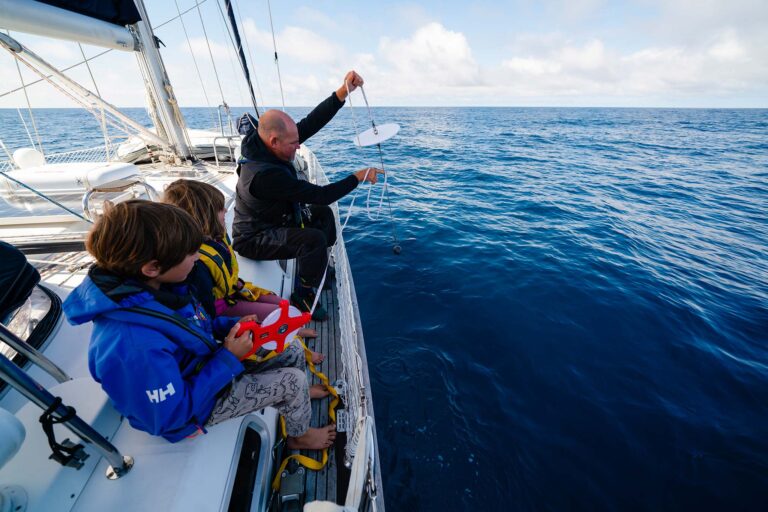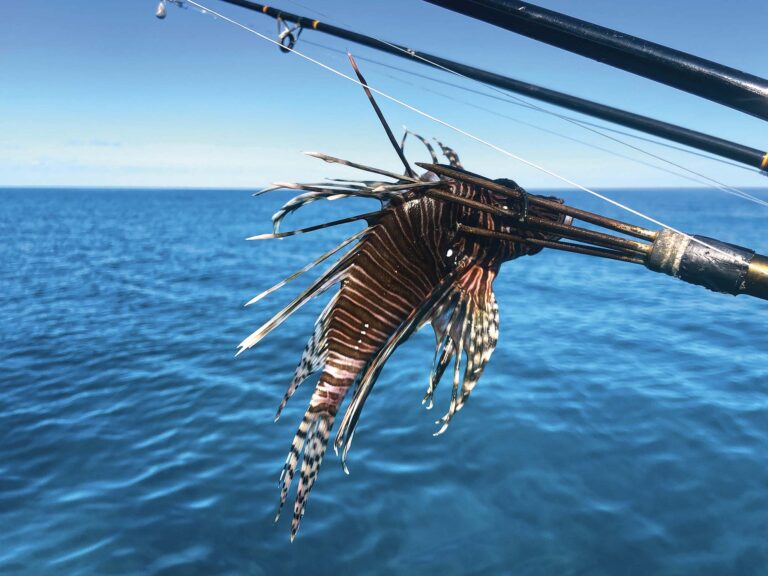
On the wall in my office is an iconic photo of legendary Swedish sailor Magnus Olsson sailing aboard the infamous Whitbread Maxi DRUM in the Southern Ocean, his arms hoisted skyward, his smile ecstatic, the boat careering down a wave at 20-plus knots with an enormous arc of spray flying off the bow wave. The photo, by Rick Tomlinson, himself a legendary Whitbread sailor and one of the OG onboard reporters, is to me the perfect expression of the pure joy that can only be felt on a boat at sea sailing fast. The photo reminds me why I love sailing.
But look closer and you’ll notice a lot of technical details to the way the crew has the boat set up: the old-school vang strap looped over the boom and lashed to the rail; the high-clewed yankee poled out to windward; the mainsheet traveler set all the way to leeward to move the sheet out of the cockpit, making access to the helm that much simpler for the crew. And most obvious of all, the deep reef in the mainsail, tied aft around the boom and lashed forward at the tack just above the gooseneck.
DRUM’s lap around the world in the Whitbread was before the days of the planing monohulls that seem never to need to reef and are always sailing on a close reach. DRUM, while huge even by modern boat standards, is a displacement boat and far more similar to the average cruising boats we sail. In the picture below, she’s sailing on a dead run, wing-on-wing, just as we would on a tradewind passage in the tropics.
I often focus on writing about offshore sailing, as that’s my primary domain, but learning how to reef is an essential skill for all sailors, no matter where you sail. The adage, “If you’re thinking about reefing, it’s already too late” remains relevant. But not all reefing systems are created equal. And not all circumstances call for the same sails to be reefed in the same order.

What Sails to Reef?
Regardless of how you reef your sails—whether slab reefing, roller furling mast/boom, old-school hank-on headsails—you must understand when to reef your sails and which to reef first.
First, look at the design of the boat and see what the original sailplan called for. Generally speaking, classic plastic boats from the ’70s, ’80s, and ’90s had huge overlapping genoas, proportionally short mainsail booms and tall, high-aspect ratio masts. Both Isbjørn, our beloved 1972 Swan 48, and Icebear, our former Swan 59, fit squarely into this category. These are headsail-driven boats—a larger proportion of the horsepower comes from the genoa.
Contrast that with Falken, our more modern Farr 65, launched in 1999. She’s designed to sail with smaller genoas and jibs and has a proportionally much larger mainsail—a mainsail-driven boat.
New boats these days tend to have even larger mainsails relative to their headsails and often have self-tacking jibs for ease of handling. These boats are even more mainsail-driven than a boat like Falken and often require a code zero or asymmetric spinnaker to maintain balance and make any sort of speed off the wind since their jibs are so small.
Lastly, look at your default sailplan, meaning which sails your normally have rigged on the boat. Your headsail size is often determined by where you sail and the local prevailing conditions. On the Chesapeake Bay where I grew up sailing, we always had huge overlapping genoas because in the summertime the wind is mostly light. This was full sail. But on boats that carry smaller jibs, your default sailplan is effectively already reefed—the small headsail being the reduced sail area.
With all that in mind, we can evaluate which sails to reef first when the wind pipes up, depending on our point of sail, our design of boat, and our default sailplan. This theory applies to monohulls and catamarans alike, by the way.

Upwind
When sailing upwind—that is, on points with wind forward of the beam, not just close-hauled—the mainsail is providing a lot of the drive and the balancing effect on the rudder. A little bit of weather helm here is a good thing; it keeps the boat pointing high and provides some nice feedback to the helmsman.
As the wind increases, the boat will heel more, and the weather helm will increase. The boat may start to leap off the waves and come crashing down in the next trough, making for thrilling but uncomfortable sailing. We can make a number of tweaks before actually shortening sail: flattening the mainsail by increasing halyard and outhaul tension; adding backstay tension to bend the mast and further flatten the main; moving the headsail car aft to flatten the jib; lowering the traveler and easing the vang to induce twist. North U has a book called Racing Trim that dives deep on the nuances of sail trim. Even if you’re not a racer, it’s worthwhile reading to learn these techniques and tools.
Upwind on headsail-driven boats, where our default sailplan includes a big genoa, we’ll reef the headsail first as it’s doing a larger proportion of the work and will have a greater impact on our sail balance. Another reason to shorten sail forward first is to maintain the drive and weather helm induced by the mainsail to maintain helm balance. If we already have the smaller genoa or jib as our default sailplan, we’d reef the mainsail first.
Likewise on mainsail-driven boats, we’d reef the main first upwind because our jib is already proportionally smaller. The goal is to maintain the boat’s balance fore-and-aft. Reefing the headsail first in this case would unbalance the boat and cause excessive weather helm. You might well drop down to the second reef in the main with a full jib before ever partially furling the jib or setting a staysail on a mainsail-driven boat going upwind.
Downwind
When the wind is free and aft of the beam, the balance of the boat changes and our reefing progression changes. Off the wind, the headsail is doing a larger part in balancing the helm, and the mainsail will create undesirable weather helm, especially in a seaway, making it more difficult to steer a straight course. First and foremost, ease that mainsheet! Almost all amateurs I sail with over-sheet their mains, giving the impression you need to reef earlier than you might otherwise, especially off the wind.
On new boats with built-in bowsprits and on most catamarans, the designer actually expects the sailor to set a code zero or asymmetric sail when off the wind to create the desired horsepower and balance the boat. If you sail with the white sails only, the boat will tend to wallow off the wind and feel unbalanced on the helm; that self-tacking jib that was so convenient upwind is now a handicap off the wind requiring a larger sail to be set in its place to maintain balance and speed.
As the wind increases sailing downwind, all boats regardless of design will want to reef the mainsail first to maintain helm balance and boat speed. In fact, on long downwind ocean passages it’s common to see cruising boats sailing double headsails on twin poles with no mainsail at all. Driving the boat becomes much easier on humans and autopilots alike when a larger proportion of the sail area is forward of the beam on angles off the wind.
Similarly, don’t be afraid to set the big sails off the wind—you’d be surprised at how a displacement boat will come alive with a spinnaker set even in enough breeze where the white sails suffice to keep boat speed up.
A word of caution: When sailing downwind it’s easy to get caught out and reef too late. As the windspeed increases, so does the boatspeed, while the apparent wind can remain constant. Before you know it, you’re barreling along at 9 knots in 25 knots of breeze under full sail, on the edge of wiping out and making reefing that much more difficult. In this instance, definitely reef the headsail first—it’s usually much faster on a furler—to slow the boat down, then reef the main, then reset any headsail to maintain the right balance. Note: Even when running downwind, prudence dictates maintaining a 150-degree true wind angle on either tack to avoid accidental jibes.

Reefing Systems
Unless you consciously made a choice when purchasing a boat, your boat will have the reefing system it has, so you’d better get used to using it properly. There was a time when roller-furling headsails were highly frowned upon as finicky, unreliable contraptions that would fail often and with dire consequences. Hank-on headsails were the only seamanlike way to sail.
Nowadays of course that’s debunked, but the feeling persists, especially among ocean sailors (myself included), regarding roller-furling mainsails, either in-mast or in-boom. But don’t be fooled; the bottom line is that any modern, well-designed, well-maintained, and properly used reefing system can be made reliable. It’s so rare to see cruising boats with hank-on headsails that I won’t even touch on that in this piece, just assuming that everyone has roller furling headsails. (For more on that, read “Shorthanded Sailing: The Case for Simplicity” March 2024)

Headsail Reefing
We’ll start with the assumption that you have a modern, well-designed, and well-maintained headsail furling unit. Whether it’s hydraulic, electric, or manual makes no difference. There are three major factors in how furlers are used to ensure reliability and lack of failures.
Avoid halyard wraps. All furlers will have instructions in the manual on the angle at which the headsail halyard must meet the top swivel. If this angle is impossible to attain, a halyard restrainer must be installed on the mast to redirect the halyard after it exits the mast. Halyard wraps are impossible to see from deck level and can cause catastrophic failure not just to the furler but to the headstay itself, risking dismasting. Avoid them at all costs.
Furl off the wind. By turning the boat downwind, you reduce the apparent wind dramatically, can blanket the headsail behind the main, and significantly reduce the loads on the furling drum, swivel, and headstay. You’ll also avoid flogging the sail, which saves wear and tear on the sailcloth, sheets, and everything else.
Careful with the electrics. Electric winches and hydraulics are becoming common on today’s boats, and while they’re certainly convenient, they can quickly overload and break something. When reefing, use them with extreme caution. We always try to furl manually by pulling on the furling line by hand, even on Falken, which is 65 feet long and has huge headsails. If you must use a winch or hydraulics/electrics, pay strict attention to the loads, make sure you’re off the wind, and stop if you sense any sort of overload. It’s good practice to have a very light breaker on electric/hydraulic furling systems so that the unit will simply shut down if overloaded rather than break something.
Mainsail Reefing
In order of preference, my favorite mainsail reefing systems are: slab reefing with single reef lines and horns/tackle at the gooseneck; slab reefing with double reef lines; slab reefing with continuous reef lines (if properly installed); in-mast furling; in-boom furling.
Note that these are in order of reliability, and that for the type of long-distance ocean sailing we do, reliability will always be a top priority. Slab reefing can never fail; you will always be able to get the sail down, you can always get the correct shape on a reefed mainsail, which is very important upwind, and with full sail, you can carry a larger roach to increase sail area.
Slab reefing relies on friction-free leads on the reefing lines, which is why I put continuous-line reefing as my third choice. It’s almost impossible to fairly lead a single line that puts tension on both the reefed clew and reefed tack to get a good sail shape, so it’s usually not worth trying. If you want slab reefing that can be controlled from the cockpit, double-line reefing is the way to go, but with three reefs, you’ll have six lines leading aft, plus the halyard, which requires a lot of clutches (and makes a ton of spaghetti).
My favorite slab reefing setup is an adaptation of the old-school horns on the gooseneck that hook around webbed dog bones at the reef tack; instead of horns and dog bones, use either a block and tackle mounted under the gooseneck that clips to the tack and then is tensioned to pull the tack down; or a winch mounted just below the gooseneck on the aft face of the mast and led to a tack line which can be clipped at the reef points. While this requires going on deck, it’s much easier than wrestling a dog bone over those old reef hooks.
I am starting to come around to in-mast furling as the top choice for most cruising sailors, with a couple caveats. It’s super easy to reef shorthanded from the safety of the cockpit. You can reef “infinitely,” meaning there are no fixed reef points—just put the right amount of sail out for the conditions. It’s less sensitive to wind angle and boom angle when reefing, and it’s easy to put the boat away at night with no sail covers and no flaking.
However—and this is a huge downside—if in-mast furling fails, it can be catastrophic. If the furling mechanism jams, the sail can get stuck partially furled. The only way to get it down is to go aloft and cut it down. For most sailors who don’t venture offshore, this is an acceptable risk. For those who do go offshore this is also an acceptable risk, but the maintenance and proper use of the system must be a top priority to mitigate this risk as much as possible.
I placed in-boom furling as my third choice—after slab or in-mast systems—because I’m not comfortable with certain aspects of this system in terms of offshore work. The mechanism is so sensitive to wind angle and boom angle that it can be hard to safely reef in a seaway without breaking something, flogging the main, or hurting someone; downwind reefing is problematic at best. And, the boom becomes excessively heavy with all that extra gear.
That said, in-boom furling presents several attractive features that make it a choice for many sailors. Unlike in-mast furling, you can always get the sail down by just dropping the halyard if the mechanism fails. You can carry full battens and a full roach, and it keeps the weight down low as opposed to in the mast.

Headsail Terminology and Sail Area/Displacement Ratios
A genoa is a headsail that is larger than the area of the foretriangle, which is created by the front of the mast, the foredeck, and the headstay, and which generally overlaps the mast when trimmed for close-hauled. Cruising boat genoas are expressed in terms of percentages of this area; Isbjørn, for example, carries a 135% and a 105%. Racing boats use terms like G1, G2, and G3 to express sizes, the lower numbers indicating a larger size.
Jibs, on the other hand, are headsails with less than 100% of the area of the foretriangle that won’t overlap the mast when trimmed tight. Cruising boats might carry an 85% jib, whereas racing boats might have a J1, J2, or J3.
We can look at the boat’s sail area to displacement ratio (SA/D) to get a glimpse at its power and, in turn, how quickly she’ll need to be reefed when the wind picks up. Isbjørn has a pretty moderate SA/D of 15.6, which implies a boat that won’t be overpowered very quickly as the wind increases and may struggle a bit in very light winds. Falken, conversely, has an SA/D of 21.6, indicating a fast boat in light airs but one that will need to be reefed much earlier to maintain balance and control.
You can usually find your own boat’s SA/D numbers online or from the manufacturer. If not, it’s a fairly simple calculation that Bob Perry elegantly describes in his wonderful book Yacht Design According to Perry.

Mainsail Reefing Steps
With practice and proper setup, all mainsail systems should be able to reef on any point of sail, including off the wind (except for in-boom, as mentioned above). The key is low friction on all lines and sheaves, and care in not getting the sail hung up in the standing rigging as it comes down. Often, bringing the boat slightly higher on the wind will mitigate this, but you should never need to come head-to-wind as you would when setting sail.
As with headsail furling, use extreme caution with electric or hydraulic systems; pay attention and get someone in position where they can see the sails as the reefing is happening.
Slab Reefing: the most reliable and most forgiving system. All of this can be done on any point of sail, including running downwind, without altering course, so long as you’re paying attention.
1. Ease the sheet to luff (not flog) the mainsail.
2. Ease the vang (or take up on topping lift to “scandalize” the main).
3. Drop the halyard while taking in slack on reef lines to avoid tangles.
4. Attach the tack/tension tack reef line and tension the halyard.
5. Tension the reef clew.
6. Re-trim the vang.
7. Re-trim the mainsheet.
In-Mast Furling: If you insist on a furling system, this is the one to have—more reliable, easier to use, and safer offshore with a lighter boom. But a minor risk of a major failure needs to be accounted for, especially on voyaging boats, and while vertical battens make a full roach possible, they add significant complication to the mechanism and increase chances of it jamming. Off the wind, some in-mast furling systems work better on a certain tack; check the manual and make note of this, even though it’s not always possible to be on the favored tack when reefing.
1. Check if you’re on the favored tack. If not, can you be? If you can’t, pay closer attention to snags.
2. Ease the sheet to luff (not flog) the mainsail.
3. Set the vang/topping lift to the correct boom angle per manufacturer’s guidance. You should have this pre-marked on all control lines so it’s a simple operation.
4. Incrementally ease the outhaul and take up on the furling line until desired sail size is reached. Do this very carefully with eyes on the sail to watch for snags.
5. Re-trim vang.
6. Re-trim sheet.
In-Boom Furling: The most finicky reefing system, which requires perfect maintenance and utmost attention when reefing. The system can make the boom heavy and difficult to control, and apparent wind angle is crucial. Difficult or impossible to reef downwind.
1. Sail onto the required apparent wind angle per manufacturer’s guidance (usually about 60º).
2. Ease the sheet to luff (not flog) the mainsail. Don’t let the boom flog.
3. Set the vang/topping lift to the correct boom angle per manufacturer’s guidance. You should have this pre-marked on all control lines so it’s a simple operation. This angle is usually crucial on in-boom furling systems.
4. Incrementally ease the halyard and take up on the furling line until desired sail size is reached. Do this very carefully with eyes on the sail to watch for snags.
5. Re-trim vang.
6. Re-trim sheet.
7. Sail back onto desired course.
Final Thoughts
I am struck by the continuing desire of sailboat and hardware manufacturers to make things easier when we’re sailing. Reefing of course is top of the list and can admittedly be difficult, wet, and annoying. But this begs the question, why? Just because you can, doesn’t mean you should.
Why do we go sailing? To do something. Sailing in an active sport; you gotta earn that sundowner somehow, right? Save the relaxation for the anchorage.
I say this simply to remind you to think consciously about whether and how many systems of convenience you need on a sailboat, because every one of them, especially reefing, carries with it serious caveats that can have serious consequences.
Reef Progression in Practice
In practice, using Isbjørn and Falken as examples of headsail- and mainsail-driven boats respectively, a typical reefing progression would look like this:
Upwind
(windspeed apparent):
Falken
Up to 22 knots: full main, full jib
22-25: 1 reef, full jib
25-28: 1 reef, staysail (or partially furled jib)
28-32: 2 reefs, staysail
32+: 3 reefs, staysail/storm jib (more likely hove-to!)
Isbjørn
Up to 15-18 knots: full main, 135% genoa
18-22: full main,
105% genoa
(or partially furled 135%)
22-25: 1 reef, 105% genoa
25-28: 2 reefs, staysail, or partially furled 105%
28+: 3 reefs, staysail
Downwind (wind aft of 90º apparent) Note we’ll rarely heave-to off the wind; conditions downwind are usually comfortable enough to continue sailing, even in very big breeze.
Falken
Up to 15 knots: full main, spinnaker
15-20: full main, full yankee
20-25: 1-2 reefs,full yankee
25-28: 2-3 reefs, partially furled yankee
28-35: 3 reefs, staysail
35+: 3 reefs (or no main), storm jib
Isbjørn
Up to 15 knots: full main, spinnaker or 135% genoa
15-20: full main, 135% genoa
20-25: 1-2 reefs, 135% genoa
25-28: 2-3 reefs, partially furled 135% genoa
28-35: 3 reefs, staysail
35+: 3 reefs (or no main), storm jib
Learn more at 59-north.com.

June/July 2024



